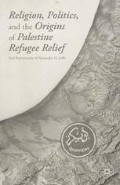Abstract
As the momentum increased for ever-larger international solutions to the refugee problem, the AFSC became more anxious. Other UNRPR aid organizations were expressing similar concerns about funding, and swift withdrawal, directly to the Secretary General.1 One new approach was proposed in a May 18 letter from Elmore Jackson to Clarence Pickett. Jackson noted that he had heard that former US President Herbert Hoover had at last become interested in the Palestine Arab refugee problem. Building on this, he then asked Pickett “Would it be feasible for thee to take the lead in setting up a committee in the United States composed of people who have been or are relatively neutral with regard to the Arab-Jewish conflict, but who feel a deep obligation to try to help and find a satisfactory overall approach in which each country in the Middle East could play its part.”2 Jackson went on to suggest that such a committee should come out in support of the Conciliation Commission’s proposals, whatever they may be.
Access this chapter
Tax calculation will be finalised at checkout
Purchases are for personal use only
Preview
Unable to display preview. Download preview PDF.
Notes
Peretz, Israel and the Palestine Arabs, 4. See generally Alexander Bligh, “Israel and the Refugee Problem: from Exodus to Resettlement, 1948–52,” Middle Eastern Studies 34, no. 1 (1998): 123–147.
AFSC 1949. Conference with Aubrey Eban, Israeli Representative to the United Nations on May 20th. See also Caplan, Futile Diplomacy, 90–100; Mordechai Gazit, “Ben-Gurion’s 1949 Proposal to Incorporate the Gaza Strip with Israel,” Studies in Zionism 8, no. 2 (1987): 223–243.
See Peter L. Hahn, Caught in the Middle East: U.S. Policy toward the Arab-Israeli Conflict, 1945–1961 (Chapel Hill: University of North Carolina Press, 2004), 102–106.
Hahn, Caught in the Middle, 106; Peter L. Hahn, “The View from Jerusalem: Revelations about U.S. Diplomacy from the Archives of Israel,” Diplomatic History 22, no. 4 (1998): 514–515.
Compare Maya Rosenfeld, “From Emergency Relief Assistance to Human Development and Back: UNRWA and the Palestinian Refugees, 1950–2009,” Refugee Survey Quarterly 28, no. 2–3 (2009): 294, n. 24, who appears to believe that the ESM’s development paradigm was solely function of Clapp having been a TVA official rather than a policy of the US State Department.
See generally Arthur Ernest Morgan, The Making of the TVA (Buffalo, NY, Prometheus Books, 1974). Hydraulic engineer Arthur E. Morgan was the president of Antioch College and the first chairman of the Tennessee Valley of Authority.
Compare Morgan’s account with Richard A. Colignon, Power Plays: Critical Events in the Institutionalization of the Tennessee Valley Authority (Albany: State University of New York Press, 1997). Born a Unitarian, Morgan became a Quaker and was also father of AFSC Gaza volunteer Ernest Morgan.
David Ekbladh, “Mr. TVA: Grass-Roots Development, David Lilienthal, and the Rise and Fall of the Tennessee Valley Authority as a Symbol for U.S. Overseas Development, 1933–1973,” Diplomatic History 26, no. 3 (2002): 335–374.
Unsurprisingly, the Ruwalla remained resolutely nomadic throughout the 1950s and 1960s, adopting motor transport and only leaving Syria temporarily in 1959 as a result of drought. See Norman N. Lewis, Nomads and Settlers in Syria and Jordan, 1800–1980 (Cambridge: Cambridge University Press, 1987), 137.
FO 371/75439, E 11297/1821/131, Morton to Foreign Office, 23 September 1949. See also G. Bennett, Churchill’s Man of Mystery: Desmond Morton and the World of lntelligence (London: Routledge, 2007), 291.
Dillon S. Myer, An Autobiography of Dillon S. Myer (University of California, Berkeley, Bancroft Library, Regional Oral History Office, 1970), 246.
Gordon R. Clapp, “Adventures in Faith and Works,” Ethics 58 (1947): 60.
A.C. Ringland, The Organization of Voluntary Foreign Aid: 1939–1953 (Washington, DC, Department of State Bulletin, 1954), 386.
FRUS 1949, Vol. VI, Agreed Conclusions of the Conference of Near Eastern Chiefs of Missions, Istanbul, 26–29 November, 1949,. 173. See also James G. McDonald, My Mission to Israel 1948–1951 (New York: Simon and Schuster, 1951), 179–185.
Shlomo Slonim, “Origins of the 1950 Tripartite Declaration on the Middle East,” Middle Eastern Studies 23 (1987): 135–149.
See also Michael B. Oren, “The Tripartite System and Arms Control in the Middle East: 1950–1956,” in Arms Control in the Middle East, ed. Dore Gold (Boulder, CO: Westview, 1990), 77–87.
Copyright information
© 2013 Asaf Romirowsky and Alexander H. Joffe
About this chapter
Cite this chapter
Romirowsky, A., Joffe, A.H. (2013). AFSC, the Economic Survey Mission, and Regional Development. In: Religion, Politics, and the Origins of Palestine Refugee Relief. Palgrave Macmillan, New York. https://doi.org/10.1057/9781137378170_7
Download citation
DOI: https://doi.org/10.1057/9781137378170_7
Publisher Name: Palgrave Macmillan, New York
Print ISBN: 978-1-349-47820-0
Online ISBN: 978-1-137-37817-0
eBook Packages: Palgrave Political & Intern. Studies CollectionPolitical Science and International Studies (R0)

